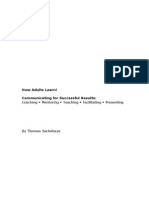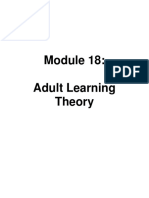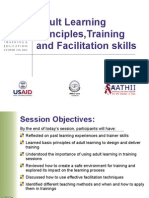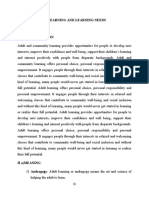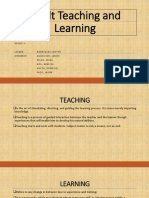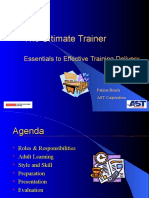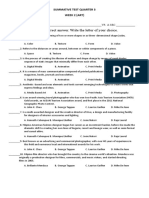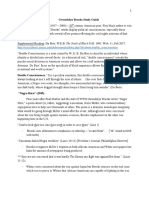6/22/2009
ADULT LEARNING STYLES:
HOW TO COMMUNICATE TO GET
RESULTS
Tracy Qualmann
When learning a new task or
skill, adults prefer life
experience examples
verses data-supported
evidence?
True or False
False
1
� 6/22/2009
Adults prefer to be given
direction and allowed to go on
their way verses the
opportunity
t it tot engage ini
relevant dialogue regarding
the situation.
True or False
False
Motivation carries no weight
in adult learning.
True or False
2
� 6/22/2009
False
OBJECTIVES
| Truths about adults and adult learning
| Things we know about adult learning
| Motivation
| Barriers to motivation
| How to be an effective facilitator
| Differences in gender communication
| How to ask the questions to get the answers
Truths about adult learning
3
� 6/22/2009
MALCOLM KNOWLES
GRANDFATHER OF ADULT LEARNING
| Adults should…
y Acquire a mature understanding of themselves
y Develop an attitude of acceptance, love, and respect
toward others
y Develop
e e op a dy
dynamic
a ca attitude
ude toward
o a d life
e
y Learn to react to the causes, not symptoms, of behavior
y Acquire the skills necessary to achieve the potentials of
their personalities
y Understand the essential values in the capital of human
experience
y Understand their society and should be skillful in
directing social change
4
� 6/22/2009
| What does learning mean…
Learning can be defined formally as the
act, process, or experience of gaining
knowledge or skills.
| Learning strengthens the brain by building new
pathways and increasing connections that we can
rely on when we want to learn more.
| Adults are on auto drive and are self-directed.
| Connect life experiences to learning
| Adults are goal-oriented
| Adults must see the relevancy
| Learning must have real-world application
| Adults demand respect
Things we know about adult
learning
5
� 6/22/2009
THINGS WE KNOW ABOUT DESIGNING ADULT
LEARNING
| Focus
| Integration
| Conflicts require time
| Conceptual overlap
| Take it slow
| Want to get it right the first time
| They take it personally
| Know your audience
| Address age-centered viewpoints
| “Anchor” concepts
| Self-directed, their pace
| Non-human media
| Application
| No isolation
6
� 6/22/2009
THINGS WE KNOW ABOUT THE LEARNING
ENVIRONMENT
| Comfortable
| Loosing one’s self
| Predetermine expectations
| Learn from one another
| Use open-ended questions
| Active participation
| Facilitator must maintain control
| Make connections
| Integration
| Situational leadership/facilitation
THINGS WE KNOW ABOUT MOTIVATING
LEARNERS
| Seek experiences with relevance
| More change, more we want
| Relationship to self
| Transitional experiences
| Learning is a journey
| Increases self-esteem
7
� 6/22/2009
Motivation
SOCIAL RELATIONSHIPS
| Make new friends
| Meet a need
| friendship
EXTERNAL EXPECTATIONS
| Compliance
y Instructions
y Formal authority
| Fulfillment
y Expectations
y Recommendations
8
� 6/22/2009
SOCIAL WELFARE
| Improvement
| Service community
| Participation
PERSONAL ADVANCEMENT
| Higher status
y Job
y Family
y Friends
| Security
y Professional advancement
y Household
| Competition
y Job
y Trends
y advances
ESCAPE/STIMULATION
| Relieve…
y Boredom
y Tension
y Monotony
| Contrast
y Newness
y Curiosity
9
� 6/22/2009
COGNITIVE INTEREST
| Learn for learning's sake
| Seek knowledge
| Inquiring minds….
Barriers to Motivation
BARRIERS
| Lack of time
| Money
| Confidence
| Interest
| Lack of information
| Scheduling
| Home life
| Perception of “can’t teach an old dog new tricks”
10
� 6/22/2009
BEST WAY TO MOTIVATE ADULT LEARNERS…
Enhance Decrease
reasons for barriers
learning
Differences in Gender
Communication
WHAT IS GENDER?
| Gender is characteristics
y Masculine
y Feminine
| Sex
y Male
y female
11
� 6/22/2009
GENDER STEREOTYPES
| Masculine male
y Body builder
y Man’s man
| Feminine male
y Florist
y Gay
| Feminine female
y retail
y Girlie girl
| Masculine female
y Athlete
y lesbian
COMMUNICATION STEREOTYPES
| Masculine/male characteristics
y Direct questions will get direct answers
| How are you today? Good. Bad. Ok. Fine.
y Open-ended questions will get a bit longer answer
| Tell me about yyour day…
y I had a nice day.
y Got everything
y g
done I wanted to accomplish.
y Body language
| Less eye contact
| Take up more physical space
| Head nod means agreement
| Feminine/female characteristics
y Direct questions will get detailed answers
| How are you today? Wow! Was it a day! At work we had these
meetings that lasted forever. Once I got home, laundry had to be
done, dishes washed and the little ones had to get to T-ball. Busy,
busy day.
y Open-ended questions will get even longer answers
| Tell me about your day… Wow! Was it a day! At work we had
these meetings that lasted forever and really never addressed any
issues I wanted to talk about. My one co-worker overtook the
meeting and made it her very own arena to air her concerns. Once
I got home, laundry had to be done, dinner had to be made,
dishes washed and the little ones had to get to T-ball. Once home
I had to give them a bath. These days never seem to end. Busy,
busy day. I could go on and on….
y Body language
| More eye contact – reassures honesty
| Take up less physical space, but more animated
| Head nod means “I hear you”, not agreement
12
� 6/22/2009
WATCH THE BODY LANGUAGE…
93% of communication
is non-verbal
non verbal
How to ask questions
to get answers
OPEN-ENDED QUESTIONS
| Not expecting a particular answer
| Open discussion
| Wide-range of answers
13
� 6/22/2009
CLOSED QUESTIONS
| Yes or no questions
| Limited detail
FACT FINDING QUESTIONS
| Aimed question
| Looking for specific answers
FOLLOW UP QUESTIONS
| Looking for more information/detail to a previous
question
| Elicit an opinion
14
� 6/22/2009
FEEDBACK QUESTIONS
| Asking what makes a difference
| Looking for opinion
| What was achieved
| Wrap up time
WHAT WE’VE DISCUSSED…
| How adults learn
| What motivates adults to learn
| How to communicate to adults
| Best ways to garner information from adults
| How to ask the right questions
| Next…how to integrate this information into your
daily workings….
LEADING BY EXAMPLE
“You should be spending, at
a minimum, 50 hours
annually on personal and
professional development”
The Leadership Challenge
Kouzes & Posner
15
� 6/22/2009
| Adults do not learn things immediately
| Need to see relevance to their lives
| Practice, practice, practice
I cannot teach anybody
anything, I can only make
them think
think.
Socrates
The art of teaching is the art
of assisting discovery
discovery.
Mark Van Doren
16
� 6/22/2009
One must learn by doing the
thing; for though you
think you know itit,
you have no certainty,
until you try.
Sophocles
REFERENCES
| Knowles, Malcom (1950) Informal adult education. Assocation Press.
Chicago.
| Kotelnikov, Vadim (2001). Getting Responses You Need: Types of
Questions.
http://www.1000ventures.com/business_guide/crosscuttings/communicati
on_questions.html#Types
| Kouzes, James & Posner, Barry. (1997) The Leadership Challenge.
Jossey-Bass,
y , San Franciso.
| Lieb, Stephen (1991). Principles of Adult Learning. Vision, fall 1991.
| N.A. (2007). The NonVerbal Dictionary of gestures, signs and body
language cues. Betterbooks.
| Peterson, Deb (n.d). Inspirational Quotations for the Teacher of Adult
Learners: Inspired Teachers Change Lives. About.com
| Robbins, Stephen (2001). Organizational Behavior. Prentice Hall, New
Jersey.
| Stewart, Lea, Cooper, Pamela, & Stewart, Alan (2003). Communication
and Gender. Allyn & Bacon. Boston.
| Zemke, Ron and Susan. 30 things we now for sure about adult learning.
Innovation abstracts, vol. WI, no 8, 1984.
17












